-
Why Machine Learning (ML) and Artificial Intelligence (AI) Are Key Technologies for SD-WAN
- What Is WAN Optimization (WAN Acceleration)?
- What Is Secure SD-WAN? | What It Is and How It Works
- What Is SD-WAN as a Service (SD-WANaaS)?
-
What Is SD-WAN Security? | SD-WAN Security Considerations
- What are the main security challenges of SD-WAN?
- What are the primary SD-WAN security features?
- What is AI’s role in improving SD-WAN security?
- What is the role of SASE in SD-WAN security?
- Do next-generation SD-WAN solutions provide better security?
- What is the difference between SD-WAN security and secure SD-WAN?
- SD-WAN security FAQs
- What Is Next-Generation SD-WAN?
-
What Is Managed SD-WAN?
- How does managed SD-WAN work?
- What are the differences between DIY and managed SD-WAN?
- Why do businesses need managed SD-WAN?
- Types of managed SD-WAN deployments
- What are the pros and cons of managed SD-WAN?
- What is the difference between managed SD-WAN and SD-WAN as a service?
- How to choose the right deployment model: managed SD-WAN, DIY, or a combination
- What Is Hybrid SD-WAN?
-
Branch Network Security | Securing Branch Networks with SD-WAN
-
What Is an SD-WAN Appliance? | SD-WAN Hardware & Equipment
- How do SD-WAN appliances work?
- What are the different types of SD-WAN appliances?
- What are the different SD-WAN appliance deployment models?
- What are the benefits of SD-WAN appliances?
- What are the common features of SD-WAN appliances?
- Security considerations for SD-WAN appliances
- How to choose the right SD-WAN appliance for your needs
- SD-WAN appliance FAQs
-
What Is an SD-WAN Gateway? | Definition, Explanation, Use Cases
- What are the limitations of hub-and-spoke architecture?
- What is the purpose of an SD-WAN gateway?
- What are the primary SD-WAN gateway use cases?
- What are the features of an SD-WAN gateway?
- What are the different types of SD-WAN gateway form factors?
- What are the disadvantages of an SD-WAN gateway?
- SD-WAN gateway FAQs
-
Top 5 Requirements for Securing Your Branch Offices
-
What are the differences between SD-WAN and SDN?
- What is SD-WAN (software-defined wide area network)?
- What is SDN (software-defined networking)?
- Primary SD-WAN use cases
- Primary SDN use cases
- What are the benefits of SD-WAN?
- What are the benefits of SDN?
- What are the potential implementation challenges of SD-WAN?
- What are the potential implementation challenges of SDN?
- What are the differences between SD-WAN and SDN?
- What are the similarities between SD-WAN and SDN?
- How to choose between SD-WAN and SDN
-
SD-WAN vs. NaaS: What Are the Differences?
- SD-WAN and NaaS in the current network services market
- What is SD-WAN?
- What is NaaS?
- What are the differences between SD-WAN and NaaS?
- What are the similarities between SD-WAN and NaaS?
- Will NaaS replace SD-WAN?
- How can SD-WAN and NaaS work together?
- What is the future of SD-WAN and NaaS?
- How to choose between SD-WAN and NaaS
- SD-WAN vs. NaaS FAQs
- How Do 5G and SD-WAN Work Together?
- SD-WAN vs MPLS vs Internet: What’s the Difference? Which is Right for Your Organization?
-
Types of SD-WAN Deployment Models: A Complete Guide
- Understanding modern SD-WAN capabilities and options
- What is SD-WAN?
- Types of SD-WAN management models
- DIY SD-WAN
- Fully managed SD-WAN
- Co-managed SD-WAN, aka Hybrid
- Managed CPE SD-WAN
- SD-WAN as a Service (SD-WANaaS)
- Types of SD-WAN deployment architectures
- Hub-and-spoke
- Mesh
- Hybrid mesh
- Types of SD-WAN deployment environments
- On-premises SD-WAN
- Cloud-based SD-WAN
- Hybrid SD-WAN
- How to choose the right SD-WAN deployment option for your business
- SD-WAN deployment models FAQs
- Top 7 SD-WAN Challenges: SD-WAN Risks, Issues, & Solutions
- MPLS | What Is Multiprotocol Label Switching
-
How to Execute an MPLS to SD-WAN Migration Step-by-Step
- Why do organizations switch from MPLS to SD-WAN?
- How is SD-WAN a better alternative to MPLS?
- What are the options for migration from MPLS to SD-WAN?
- Should you use an MSP for your MPLS to SD-WAN migration?
- What are the MPLS to SD-WAN migration challenges you can expect?
- Is there a middle ground between MPLS and SD-WAN?
- If your organization is planning an MPLS to SD-WAN migration, is SASE worth considering?
- How to create a successful MPLS to SD-WAN migration plan
- MPLS to SD-WAN migration FAQs
- How much does SD-WAN cost?
- How Does SD-WAN Automation Simplify Network Operations?
- How Are Firewalls and SD-WAN Related?
- How SD-WAN helps Today’s IoT
-
What Is SD-WAN Multicloud?
- What is the Difference Between SD-WAN and MPLS?
Traditional WAN vs. SD-WAN: What Are the Differences?
The difference between WAN and SD-WAN is that WAN is a traditional network which uses hardware-based routers and manual configuration, while SD-WAN is a software-defined solution that provides centralized control and dynamic traffic management over various connection types.
SD-WAN provides enhanced performance, scalability, cost efficiency, and security. Traditional WANs, while reliable, can be more expensive and less flexible compared to SD-WAN.
How did traditional WAN evolve into SD-WAN?
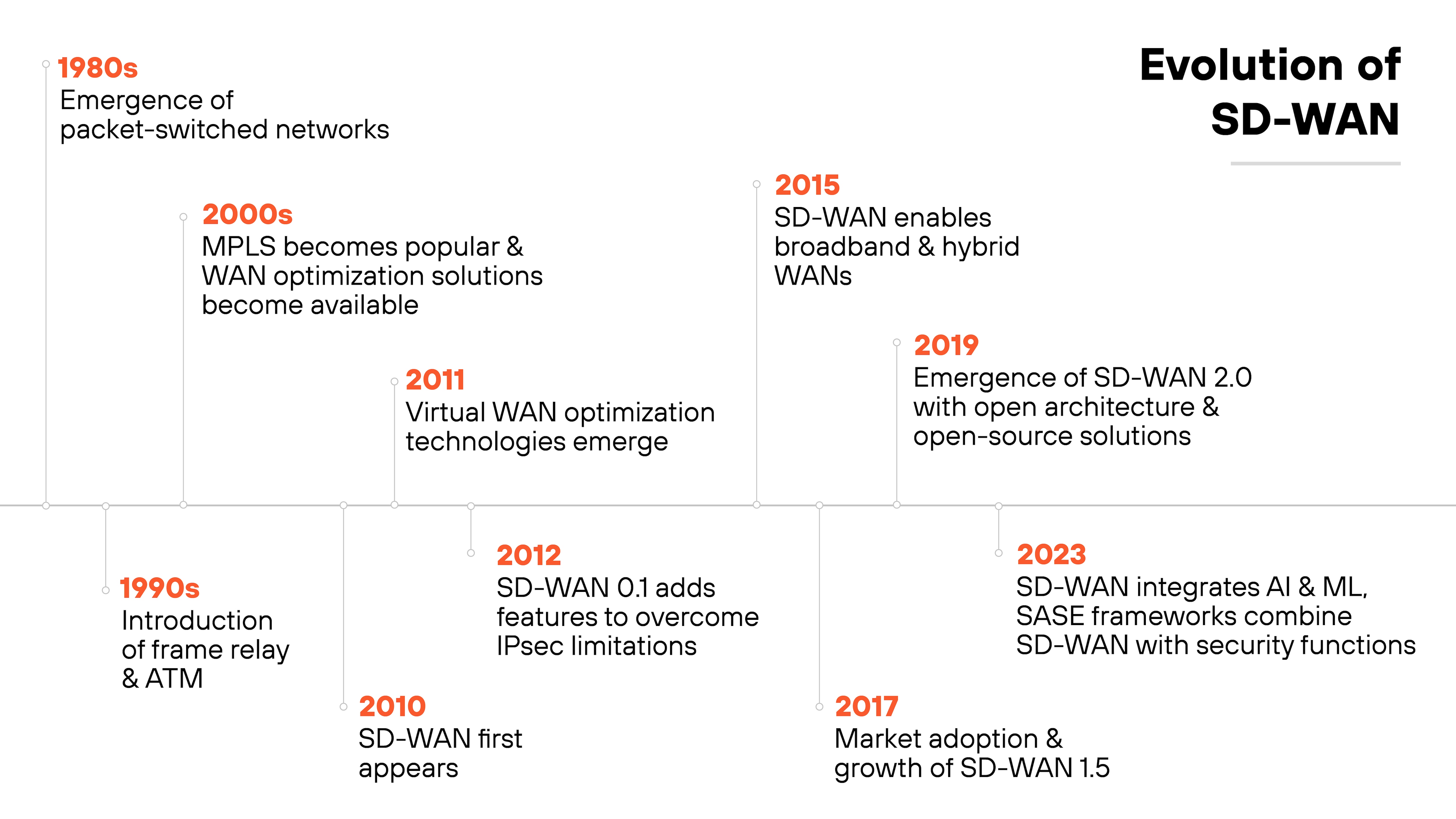
To understand the general technological differences between traditional WAN and SD-WAN, it’s helpful to first start with how they came to be.
The traditional WAN (wide area network) has long been the backbone of enterprise networking. Traditional WANs connect multiple local area networks (LANs) across large geographical areas.
Initially, WANs relied heavily on leased lines—like point-to-point and frame relay services—which provided dedicated, but expensive, connections between sites.
In the 1980s and 1990s, MPLS (multiprotocol label switching) emerged. MPLS offered a more efficient way to manage and route traffic over vast networks. It became the standard for WANs, known for reliability and quality of service (QoS).
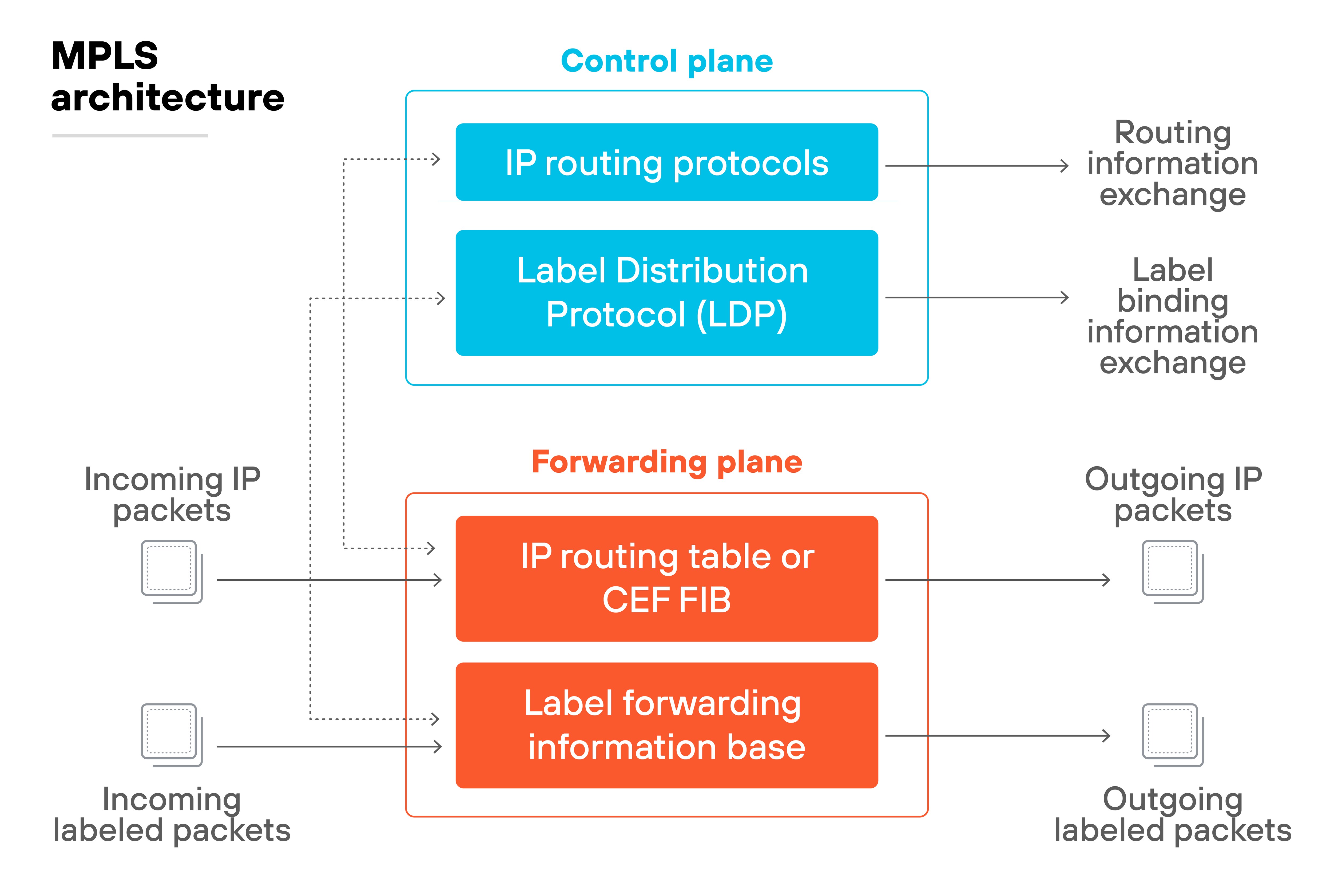
However, as cloud computing and SaaS applications grew in popularity, traditional WAN architectures began to show their limitations. The need for backhauling traffic to data centers led to inefficiencies and increased costs.
The rise of cloud-based services in the 2000s further highlighted these inefficiencies. Companies needed a more flexible, cost-effective solution to handle the increased demand for bandwidth and the shift towards decentralized applications.
This is where SD-WAN (software-defined wide area network) comes into play.
SD-WAN uses software-defined networking (SDN) principles to create a virtualized overlay network. Unlike traditional WANs that depend on physical routers and manual configurations, SD-WAN uses a centralized control plane. The control plane manages network traffic dynamically, optimizing the use of available connections—such as broadband, LTE, and MPLS—based on real-time conditions.
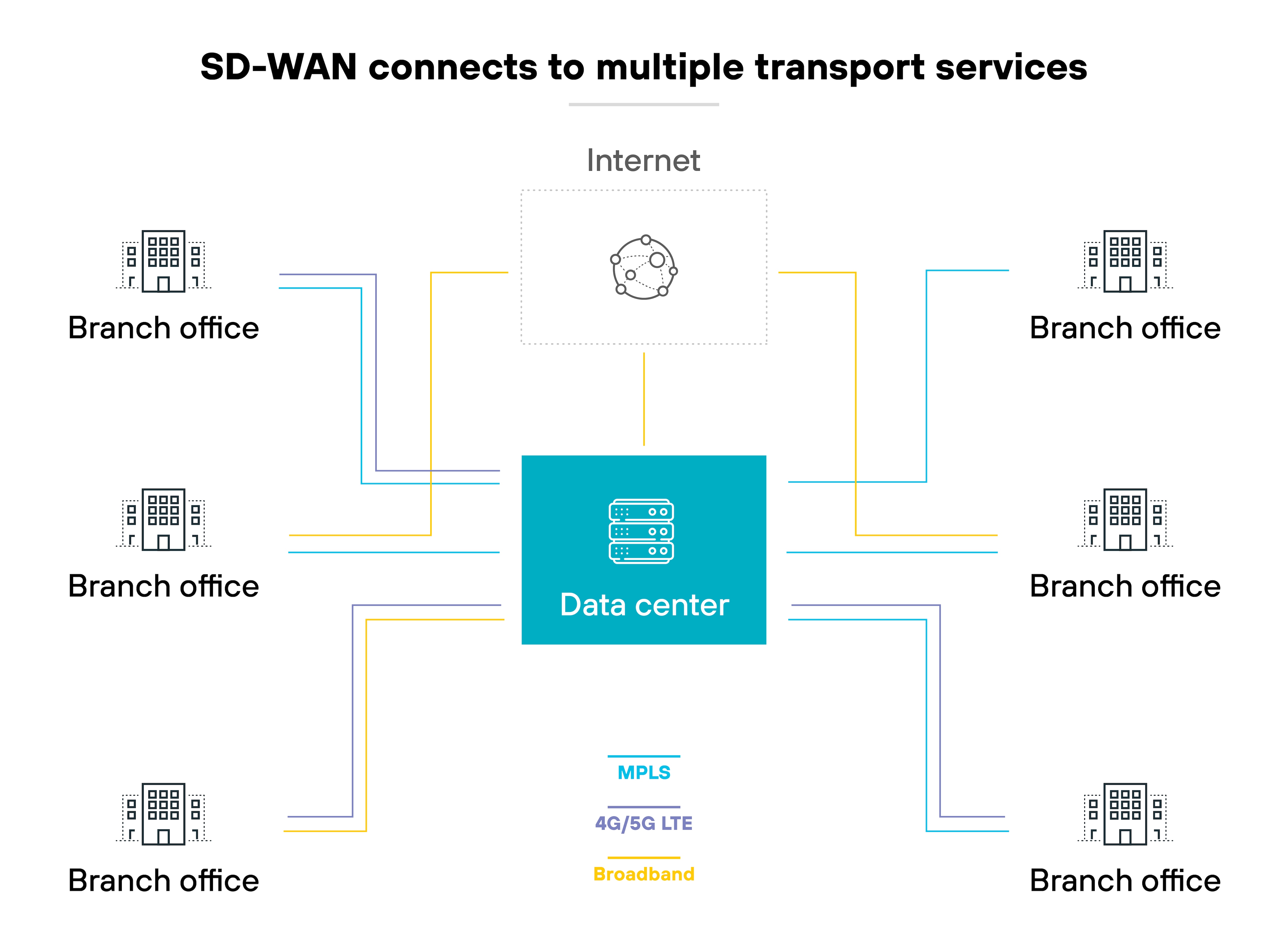
One of the key drivers for the adoption of SD-WAN solutions is cost-efficiency. By using cheaper internet connections and reducing reliance on costly MPLS circuits, SD-WAN offers a major reduction in operational expenses.
Plus, the ability to centrally manage and configure the network through software simplifies the overall network management process and reduces the need for on-site IT support.
Not to mention, SD-WAN is flexible and easier to scale. Adding new sites or adjusting to changing business requirements is a lot easier and faster compared to a traditional WAN. The centralized management and automated traffic routing allow businesses to respond quickly to new demands without extensive reconfiguration.
Further reading: What Is the Difference Between SD-WAN and MPLS?
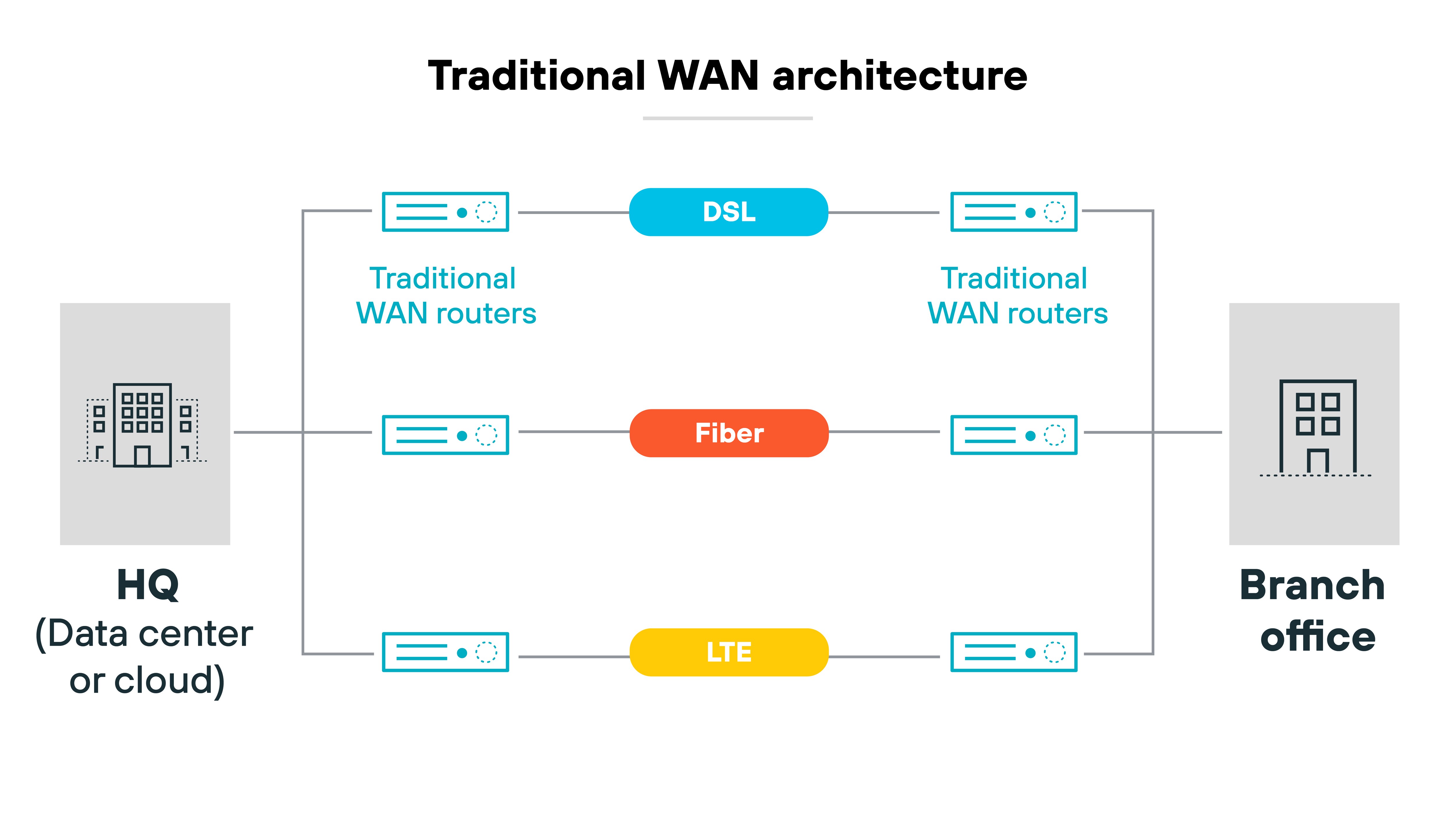
A wide area network (WAN) is a type of telecommunications network that extends over a large geographical area, connecting multiple smaller networks such as local area networks (LANs) or metropolitan area networks (MANs). WANs enable devices in different locations to communicate and share information.
WANs act as the critical infrastructure that interlinks various branches of an organization, which allows them to work as a unified entity. So employees can access central resources, share data securely, and collaborate effectively—regardless of location.
WAN technologies use a variety of transmission media and technologies to establish connections, including: traditional telephone lines, fiber optic cables, satellite links, and even wireless connections. The choice of technology generally depends on the specific needs and infrastructure of the organization.
Benefits of WANs include:
- Large geographical area coverage
- Higher bandwidth than LANs (local area network) and MANs (metropolitan area network)
- Centralized data
- Real-time file updates
- Messaging efficiency
The internet is the most well-known example of a WAN. It’s effectively a global network that connects millions of smaller networks, enabling communication and data exchange on an unprecedented scale.
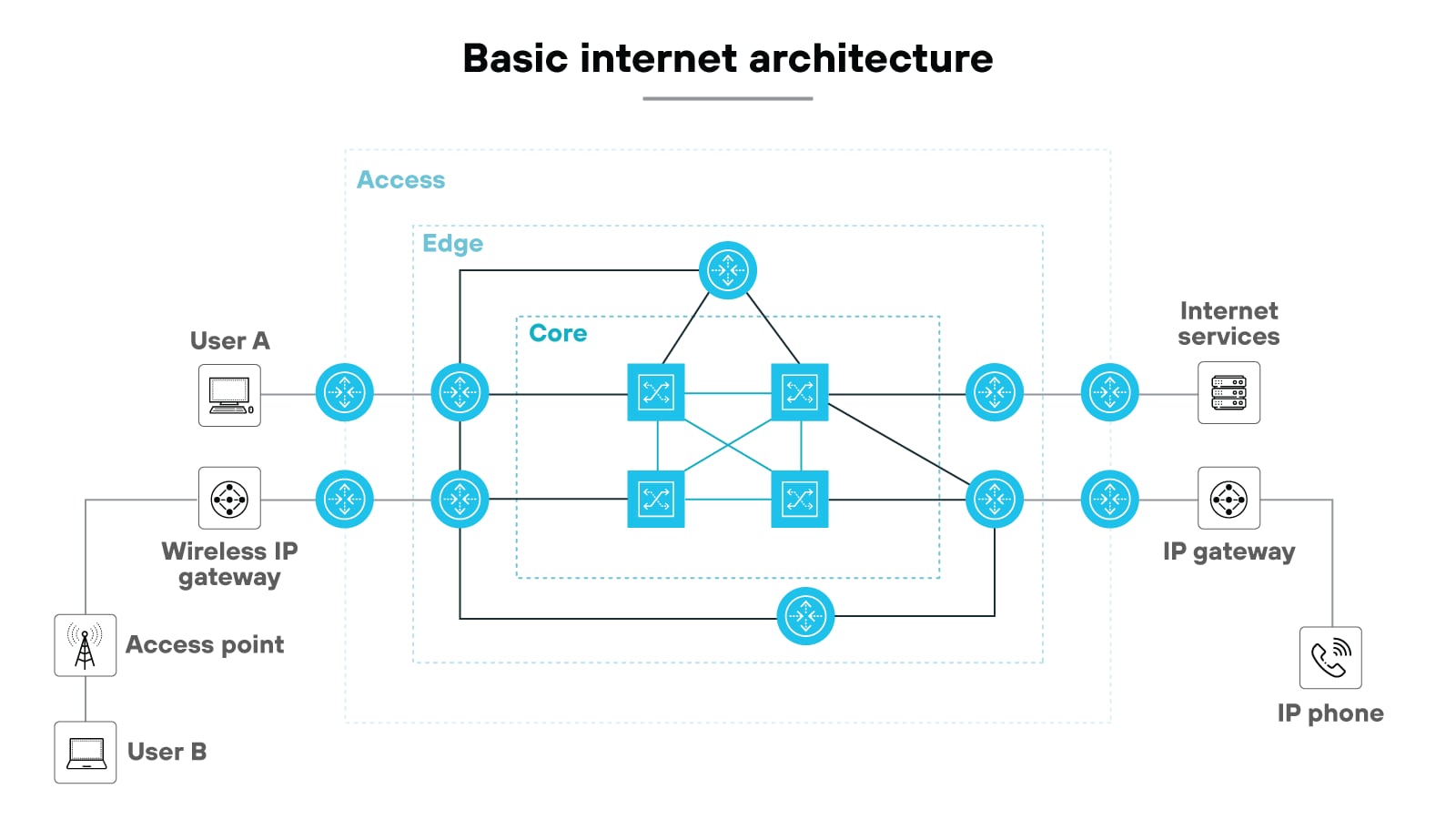
Just like the internet, enterprise WANs support large-scale communication and data transfer across vast distances.
The main use cases for WANs are:
- Branch connectivity
- Remote access
- Data center interconnectivity
- Centralized management
- IoT connectivity
What is SD-WAN?
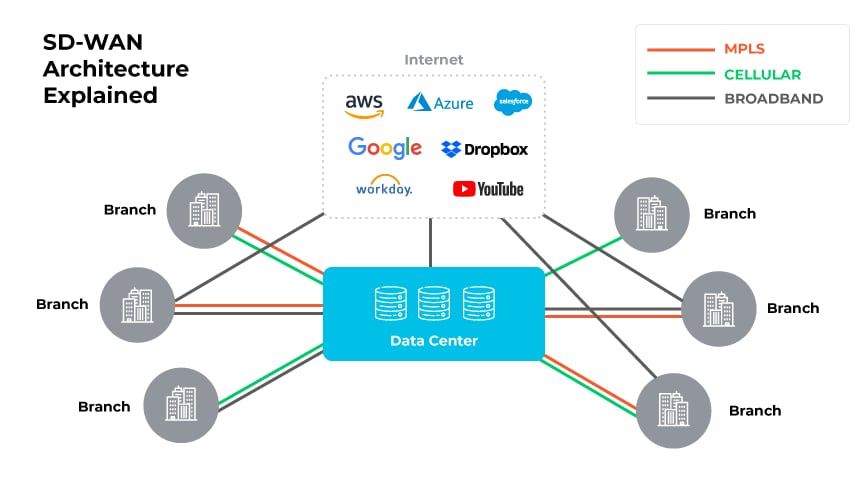
Software-defined wide area network (SD-WAN) is a modern networking technology that uses software-defined networking (SDN) principles to manage and optimize wide area networks (WANs).
It allows organizations to securely connect users, applications, and data across multiple locations. And delivers enhanced performance, reliability, and scalability.
Essentially, SD-WAN simplifies WAN management by providing centralized control and visibility over the entire network.
So, how does SD-WAN work?
SD-WAN is a virtualized service that connects and extends enterprise networks.
It uses various types of connections, including: multiprotocol label switching (MPLS), wireless, broadband, virtual private networks (VPNs), and the internet. This allows users in branch and remote offices to access corporate applications, services, and resources. Which makes working from anywhere easy.
SD-WAN continuously monitors the performance of WAN connections. It also manages traffic to maintain high speeds and optimal connectivity.
Traditional WANs rely on legacy routers to connect remote users to applications hosted in data centers. The process usually involves manually writing rules and policies. Which can be time-consuming and prone to errors.
On the other hand:
SD-WAN solutions address these challenges by using software instead of hardware. And that allows for real-time adjustments to traffic and conditions.
Like this:
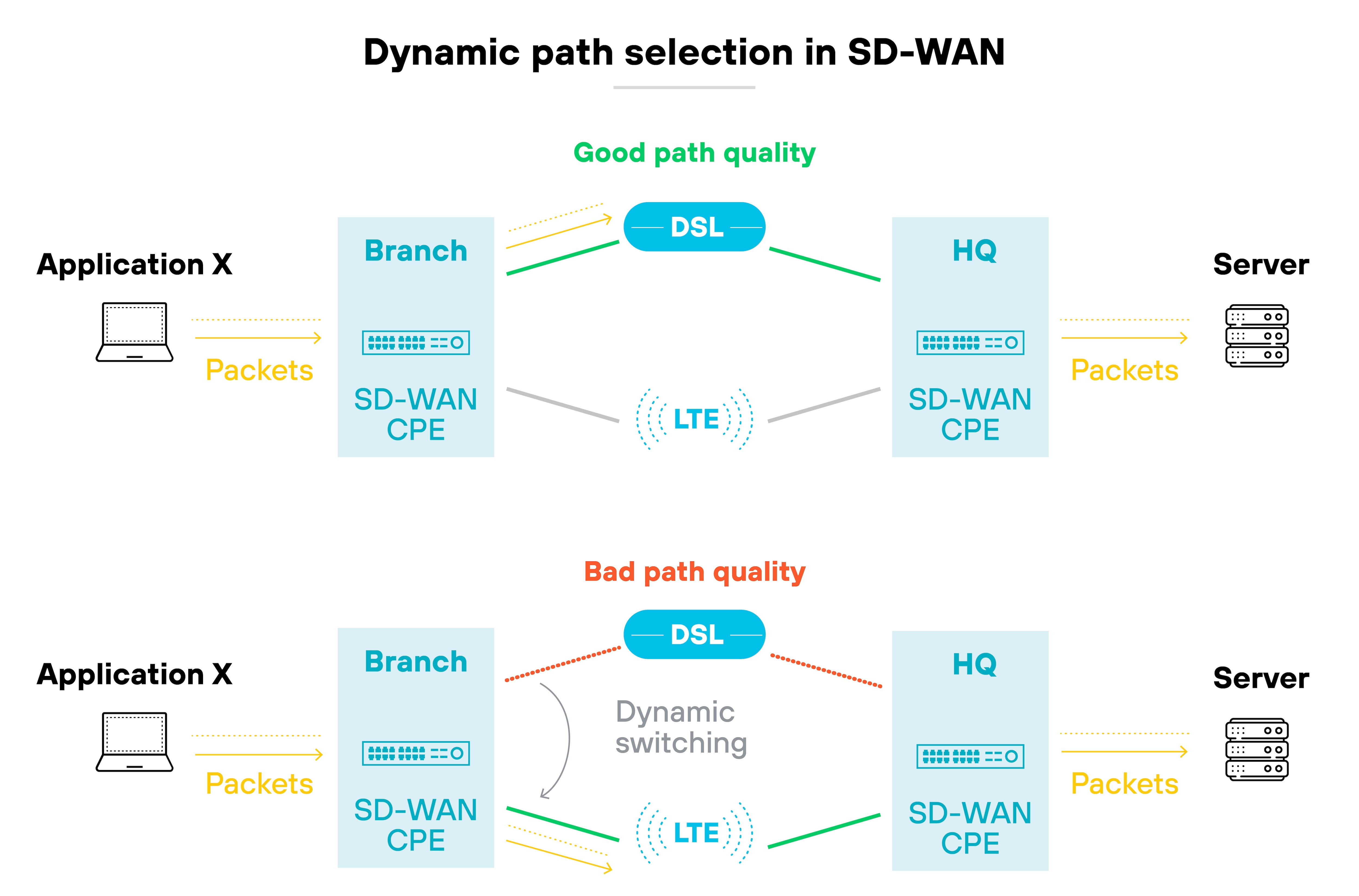
The adaptability provides much better security and reliability compared to traditional WANs.
SD-WAN architecture uses a centralized control plane to route traffic. Administrators can write rules and policies and deploy them across the entire network simultaneously.
By detaching control from the hardware, SD-WAN simplifies network management and enhances service delivery.
SD-WAN appliances follow operational regulations from a central SD-WAN controller, significantly reducing the need for individual gateway and router management.
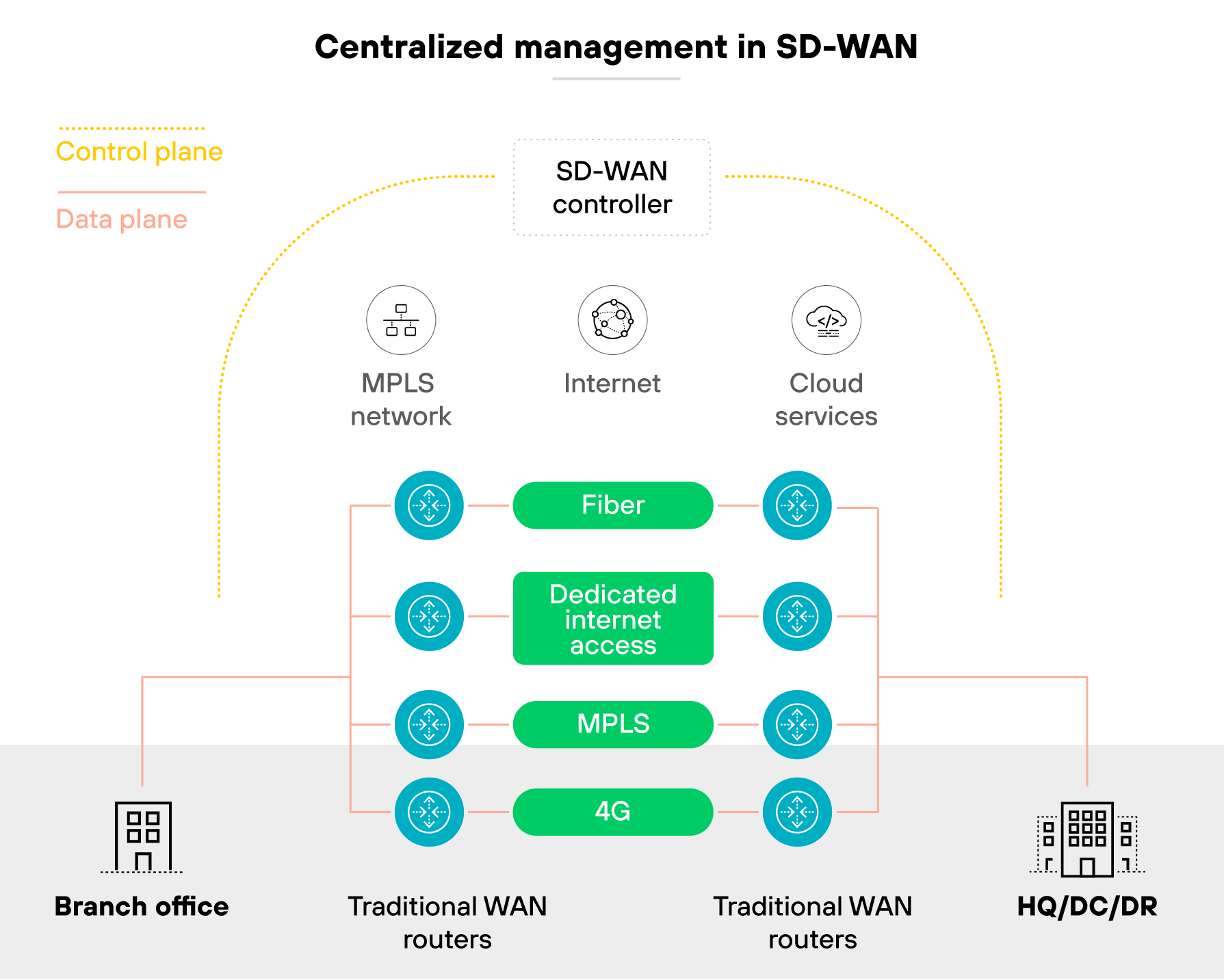
It also addresses specific connectivity issues like network congestion and packet loss.
The overall benefits of SD-WAN include:
- Operational simplicity
- Carrier-independent WAN connectivity and improved ROI
- Improved security
- Enhanced performance
- Improved connectivity and direct cloud access
- Foundation to SASE strategy
SD-WAN gateways support hybrid WAN. Meaning each branch appliance can support multiple connections via various transport methods.
For security, a VPN is typically installed across each WAN connection.
The flexibility in connection types increases network bandwidth, performance, and redundancy, which is what makes centralized management and administration possible.
Use cases for SD-WAN include:
- Branch connectivity
- Enhanced security
- Centralized management and visibility
- IoT security, connectivity, and performance
- Application control and quality of service
- Cloud connectivity and strategy
What are the differences between SD-WAN and WAN?
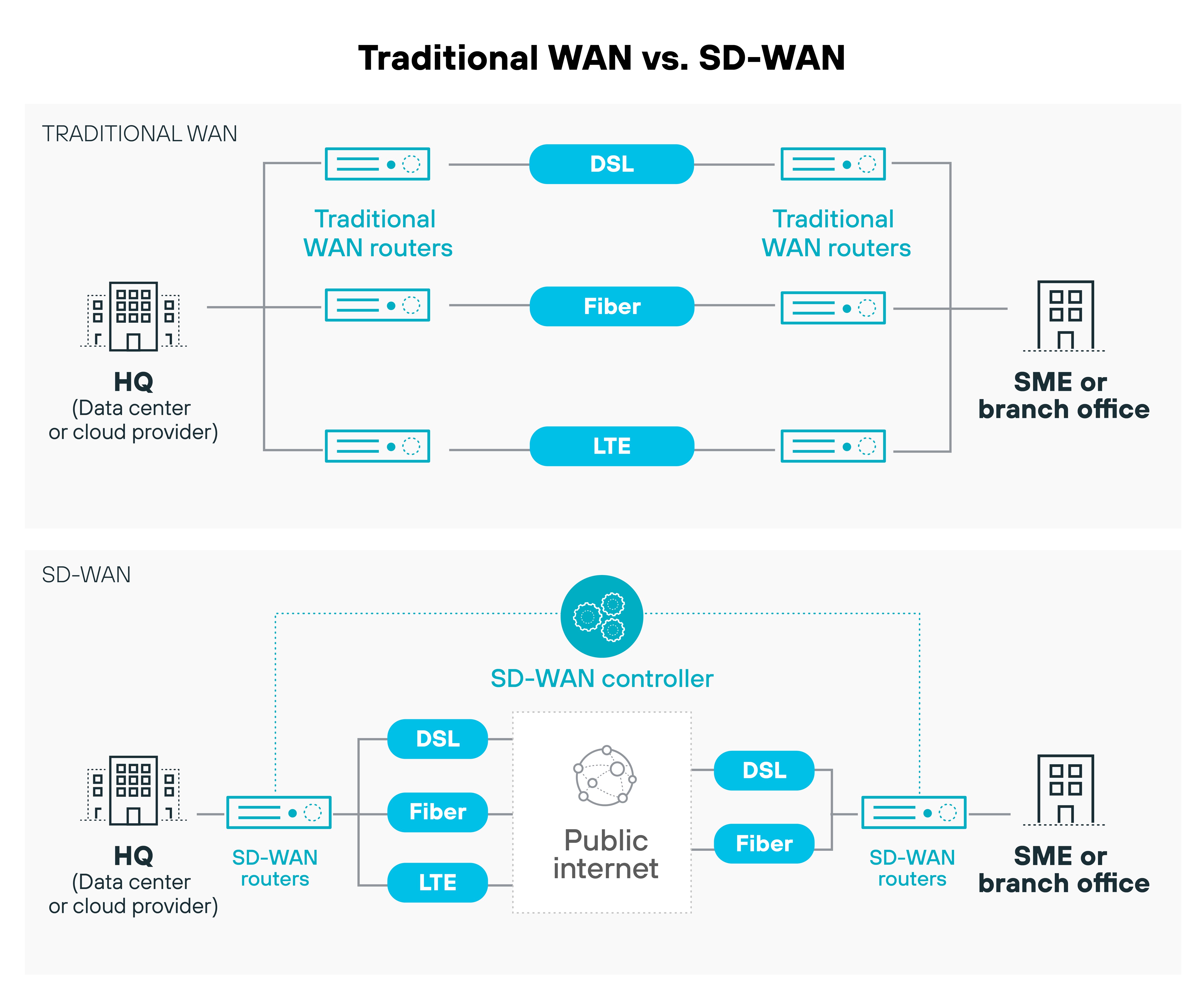
While traditional WANs have been effective in the past and are still a reliable option for certain use cases, SD-WAN offers major advantages when it comes to network management, traffic optimization, scalability, cost, and security.
These differences can make SD-WAN a more flexible, efficient solution for some organizations’ networking needs.
SD-WAN vs. WAN: What are the differences?
| Feature | Traditional WAN | SD-WAN |
|---|---|---|
| Network management | Hardware-based routers, manual configuration; time-consuming and prone to errors | Centralized control plane, policies and configurations managed from a single interface; more efficient and less error-prone |
| Traffic optimization | Fixed paths, often using leased lines or MPLS circuits; inefficiencies under changing conditions | Dynamic management using software algorithms; real-time traffic rerouting based on network performance |
| Scalability | Complex and costly expansion; requires new hardware and extensive configuration | Designed for easy scalability; quick addition of new sites using software-defined controls; integrates multiple connection types (broadband, LTE, MPLS) |
| Cost | Expensive due to dedicated circuits and maintenance, especially with MPLS | Reduces costs by leveraging less expensive public internet connections; maintains performance and reliability with a hybrid approach |
| Security | Managed through separate security appliances; complex to maintain consistent security policies | Integrated security features; end-to-end encryption and unified security policies across all locations; simplifies security management and enhances protection |
Network management
Traditional WAN relies on hardware-based routers and manual configuration. Each router has to be individually programmed, which is time-consuming and prone to errors.
In contrast, SD-WAN uses a centralized control plane for network management.
Like this:
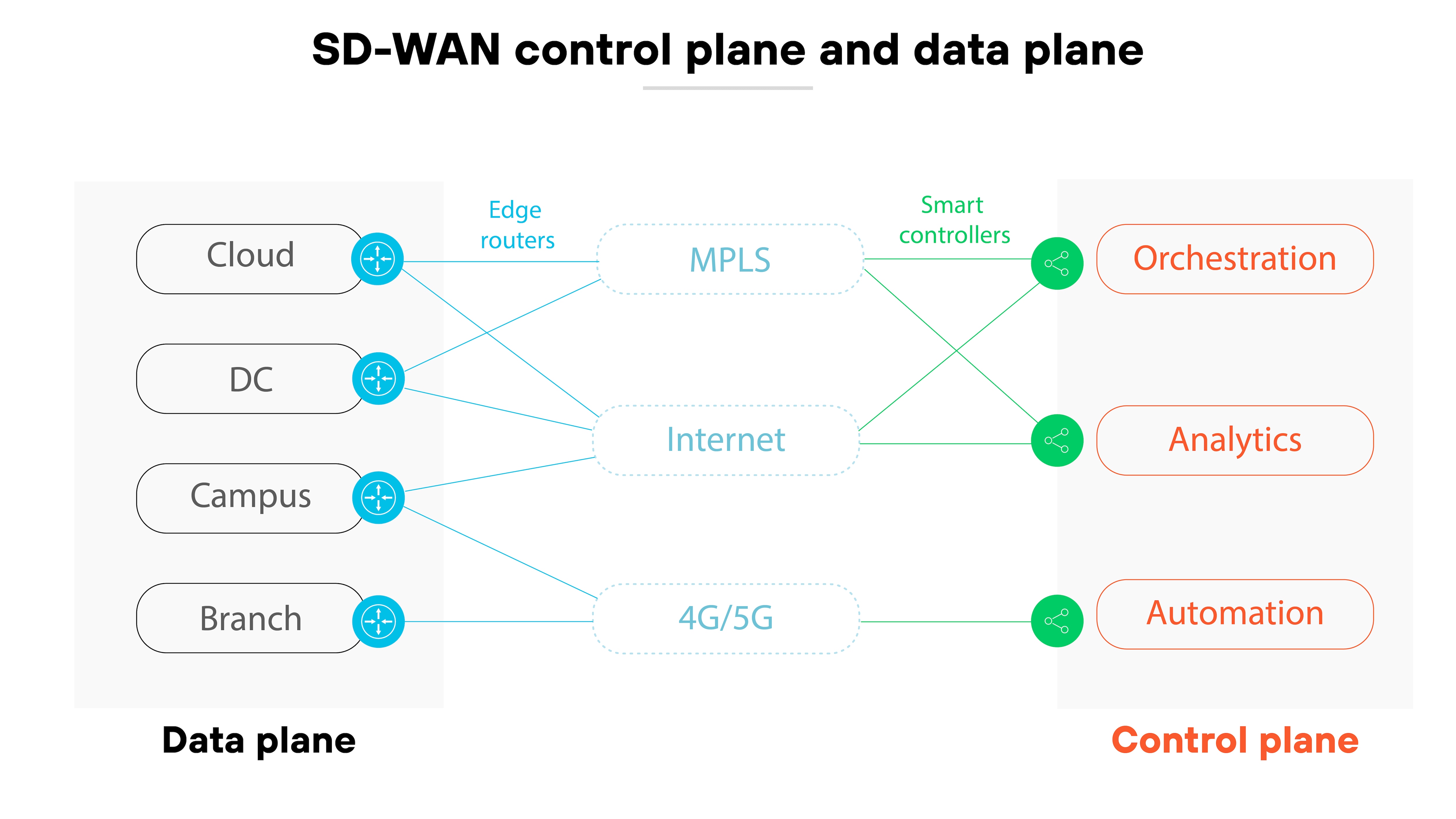
As mentioned, this allows administrators to implement policies and configurations across the entire network from one interface. Management is a lot more efficient and less error-prone.
Traffic optimization
WANs typically route traffic through fixed paths, often using leased lines or MPLS circuits. Again, this leads to inefficiencies, especially under changing network conditions.
SD-WAN, however, dynamically manages traffic using software algorithms. It can reroute network and application traffic in real time based on current network performance.
Here’s how the process works:
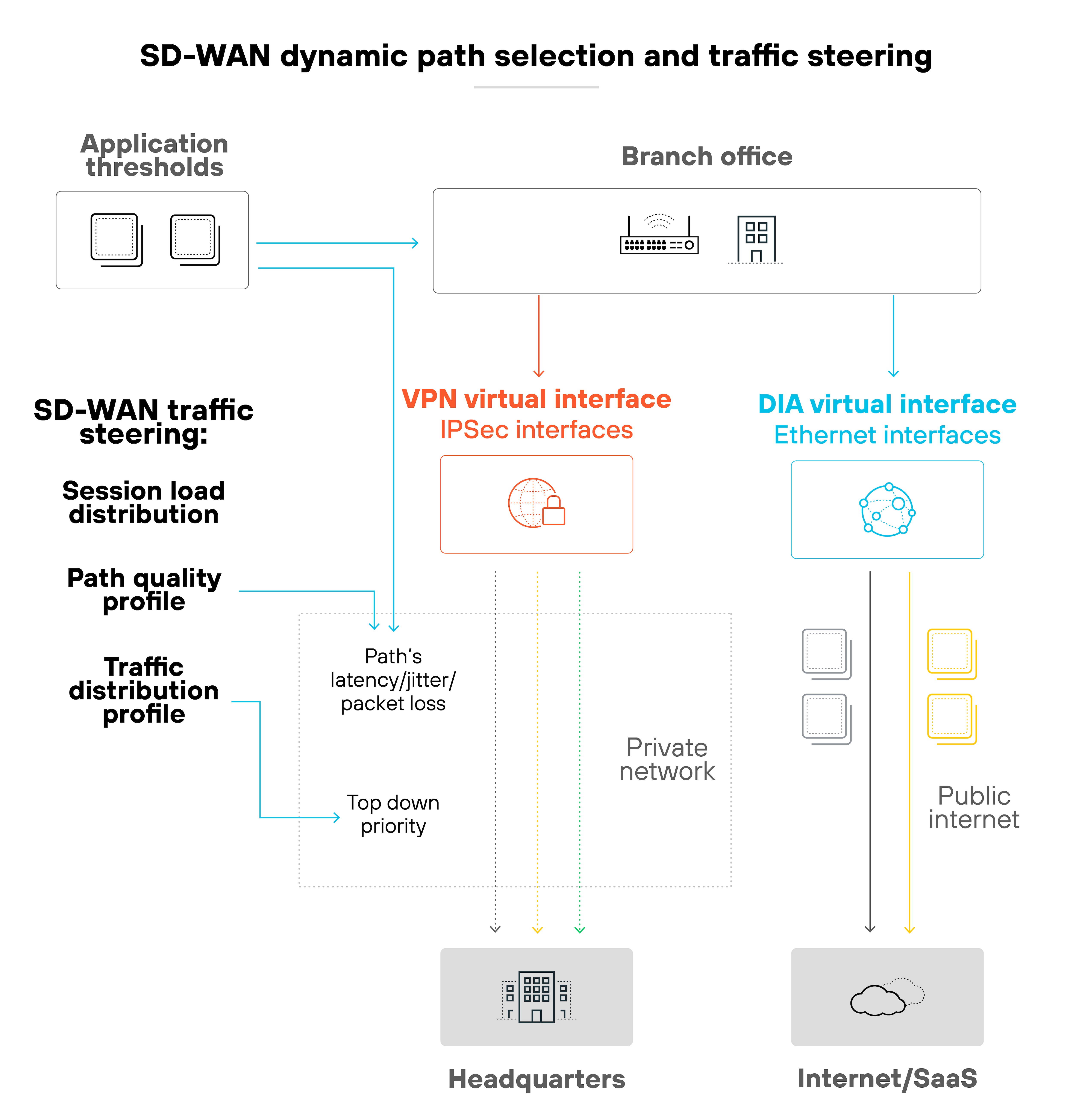
And that means organizations can guarantee the best possible use of available bandwidth while maintaining high application performance.
Scalability
Expanding a traditional WAN can be complex and costly. It usually requires new hardware and extensive configuration.
SD-WAN, on the other hand, is designed for easy scalability. New sites can be added quickly using software-defined controls.
The fact that the network can seamlessly integrate multiple types of connections also contributes to its scalability. Because the flexibility in connection options allows the network to grow and adapt to different requirements without major reconfiguration.
Cost
Traditional WANs—especially those using MPLS—can be expensive due to the cost of dedicated circuits and maintenance.
SD-WAN reduces costs by relying on less expensive public internet connections while still maintaining performance and reliability. Its hybrid approach allows organizations to increase bandwidth without significantly raising costs.
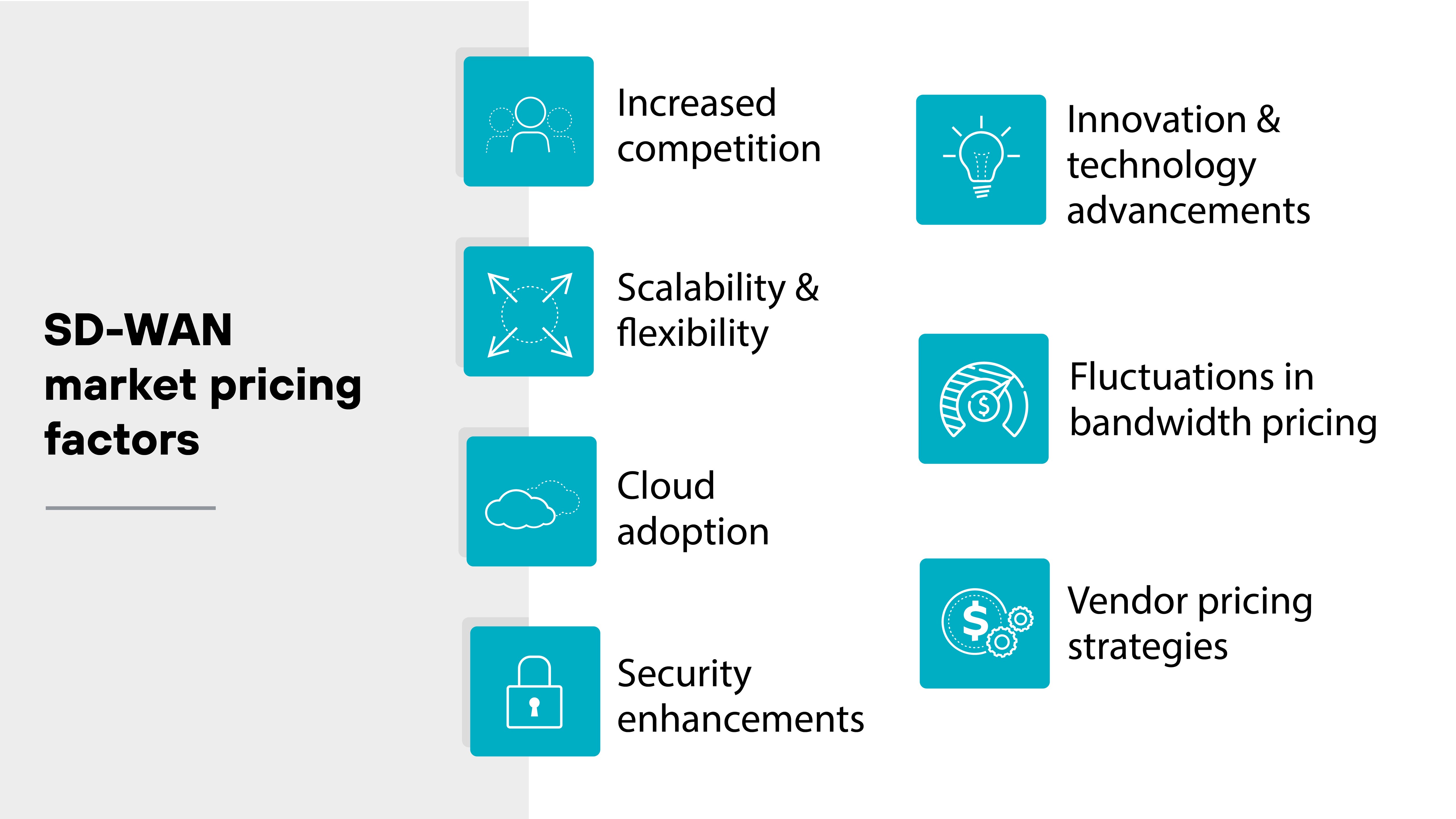
Note
While it’s true that SD-WAN can help organizations save money on network costs, savings aren’t always guaranteed. The cost of MPLS networks and diverse broadband options vary by location. Plus, initial investments can be substantial, and network complexity along with ongoing management costs can offset savings.
Security
Security in traditional WANs is typically managed through separate security appliances, making it complex to maintain consistent security policies across the network.
SD-WAN integrates security features directly into the network. It provides end-to-end encryption. Plus, it allows you to implement unified security policies across all locations. The integration makes security management simpler and improves protection overall.
Also: SD-WAN is foundational to SASE, a framework that combines networking and security functions in a single cloud-native architecture. SD-WAN provides the secure, high-performance connectivity layer that SASE builds on. SASE brings advanced security capabilities like secure web gateways (SWG), cloud access security brokers (CASB), and zero trust network access (ZTNA).
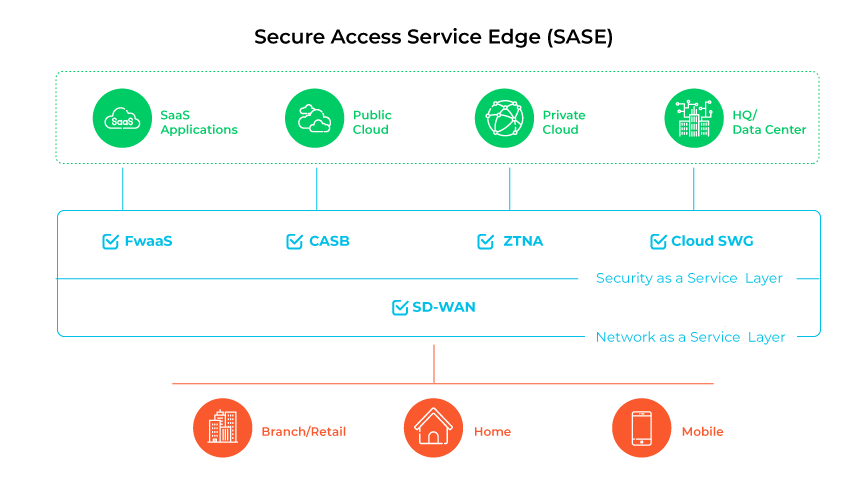
Further reading: SD-WAN vs. SASE: What’s the Difference?
What are the similarities between SD-WAN and WAN?
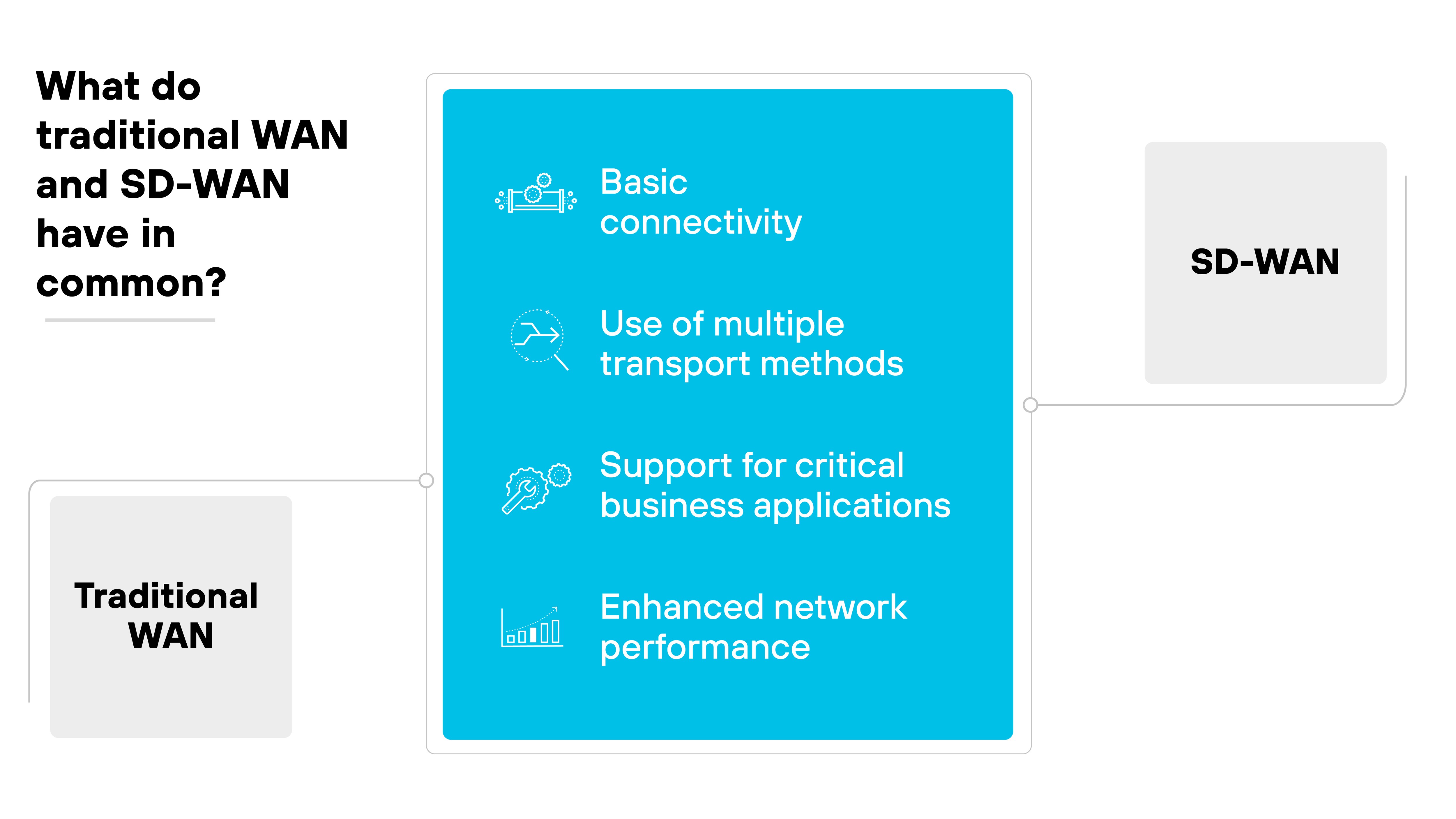
Though the two technologies have substantial differences, SD-WAN and WAN technologies also have similarities, including: basic connectivity functions, use of multiple transport methods, support for critical applications, and focus on enhancing network performance.
These shared attributes highlight the essential roles of WAN and SD-WAN in modern networking infrastructure.
Basic connectivity
Both WAN and SD-WAN provide connectivity over large areas. They connect multiple local area networks (LANs) and remote sites, allowing for communication and data sharing between different locations.
The fundamental purpose of both technologies is effectively the same, ensuring that dispersed networks can function as a cohesive system.
Use of multiple transport methods
WAN and SD-WAN both use various transport methods to establish connections. As established, these can include: MPLS, broadband connections, LTE, and even satellite links.
By supporting multiple transport methods, both WAN and SD-WAN offer flexibility in how network traffic is routed and managed.
Support for critical business applications
WAN and SD-WAN are each instrumental in running critical applications that need reliable network performance.
They make it possible to use applications across different sites so employees can access the necessary tools to perform their tasks—whether they’re in the office or working remotely.
Enhanced network performance
WAN and SD-WAN aim to enhance network performance. They both focus on providing reliable, efficient data transfer across the network. While their approaches differ, the purpose is common to both.
What makes SD-WAN a better choice over WAN?
The advantages of SD-WAN versus traditional WAN technologies can make it a compelling option for many organizations.
Note
It’s important to recognize that while SD-WAN solutions can offer significant benefits, there are scenarios where traditional WAN may still be the better choice.
SD-WAN tends to be an attractive alternative to traditional WAN because of its more modern approach to managing wide area networks. Organizations can adapt quickly to changing demands, streamline network management, and optimize overall performance.
Here’s when SD-WAN is more than likely the right decision:
- For organizations with multiple branch locations, dynamic traffic demands, or significant reliance on cloud applications.
- Businesses that need to quickly scale their network infrastructure to accommodate growth or seasonal spikes will benefit from SD-WAN’s ease of deployment and scalability.
- Companies seeking to implement comprehensive security policies across dispersed locations will find SD-WAN’s integrated security features helpful.
- Organizations looking to reduce operational costs while maintaining high network performance and reliability will see meaningful benefits from adopting SD-WAN over traditional WAN.
When is traditional WAN the right choice?
While SD-WAN offers numerous benefits, as discussed, there are scenarios where traditional WAN is still a better option for some organizations.
Traditional WANs provide reliable, high-quality connections. They tend to work well for businesses that prioritize these aspects over the flexibility and cost savings offered by SD-WAN.
Organizations with one or more of the following conditions might find traditional WAN more suitable:
- Consistent, predictable traffic patterns
- The need for dedicated, private circuits
- Limited IT resources
- Significant existing investments in WAN infrastructure
- Stable, localized operations
- Reliance on legacy applications that require specific network configurations
- QoS requirements that MPLS circuits provide
How to choose between WAN and SD-WAN
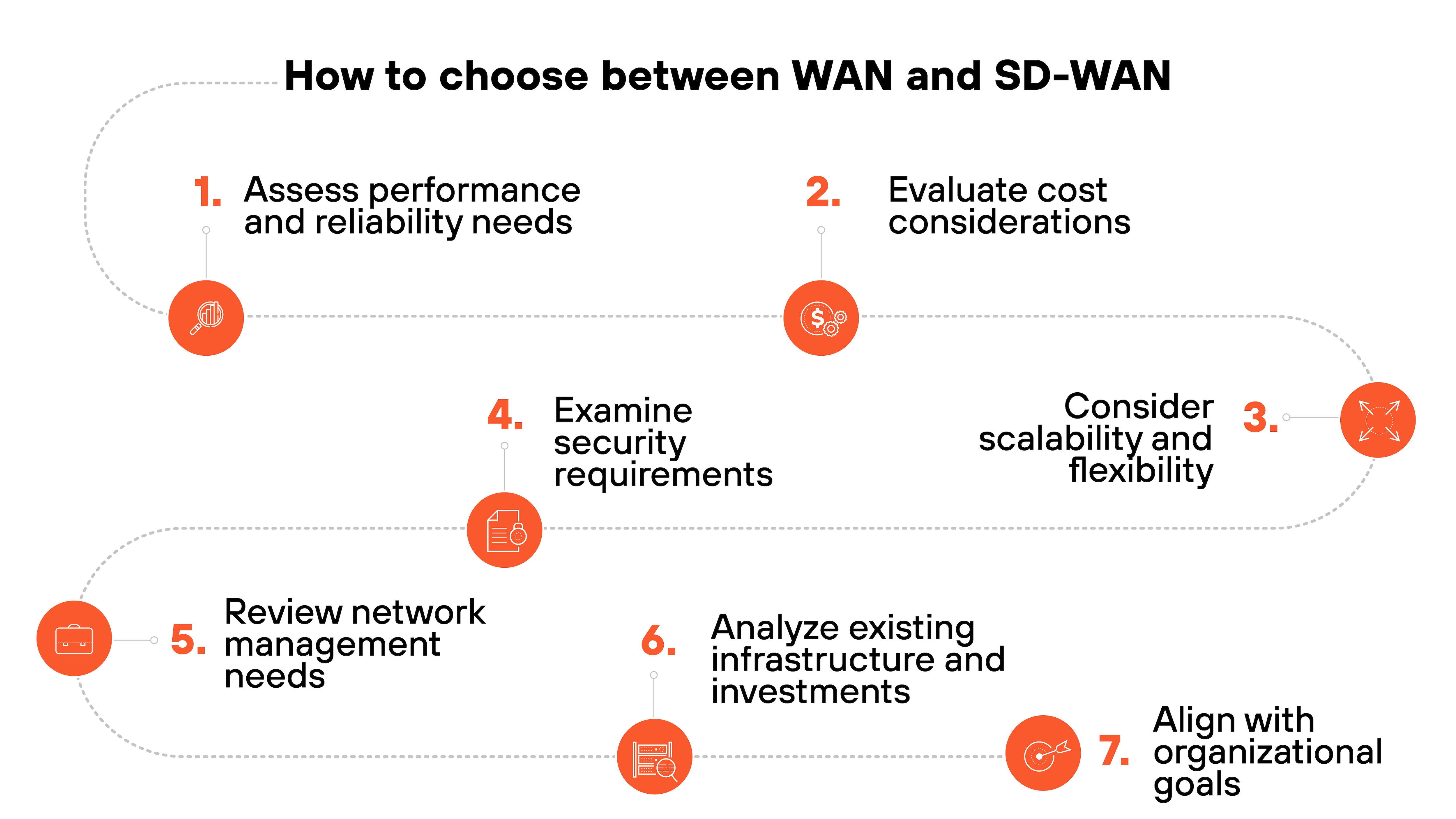
To decide between WAN and SD-WAN, you’ll need a full understanding of your organization’s unique needs, existing infrastructure, and future growth plans.
Both technologies have strengths and limitations. The choice ultimately depends on your specific requirements.
Assess performance and reliability needs
Start by identifying your network performance and reliability requirements.
If your current setup consistently meets these needs, you might lean towards staying with traditional WAN.
However, if you experience frequent downtime, latency issues, or require higher performance, you might consider SD-WAN for its dynamic routing and multiple connection paths.Evaluate cost considerations
Compare the costs of traditional WAN and SD-WAN. Traditional WANs often rely on expensive MPLS circuits, while SD-WAN can utilize cheaper mobile data and broadband connections.
The actual costs can definitely vary depending on your geography, existing infrastructure, and specific needs. So carefully assess your budget and the cost-effectiveness of both options to determine which aligns better with your financial priorities.Consider scalability and flexibility
Review your business’s growth plans and assess how easily each technology can scale with your needs. If you plan to expand geographically or frequently add new sites, consider how each solution supports this growth.
If your expansion plans are modest and predictable, traditional WAN might suffice. Especially if your current setup can handle additional hardware and configuration without extensive changes.
If rapid or frequent scaling is crucial, SD-WAN might be more suitable. Software-defined controls allow for quick, seamless integration of new sites and connections. This is particularly beneficial if your business needs to adapt swiftly to changing conditions or unexpected growth.Examine security requirements
Analyze your security needs and determine how each technology aligns with your security policies.
If your organization requires dedicated circuits, traditional WAN might be more appropriate. It provides strong security through dedicated, private connections, which can be critical for industries with stringent security requirements.
If centralized security management is important, SD-WAN might be a better fit. It offers features like end-to-end encryption and unified threat management, which can simplify managing security across multiple locations. Consider SD-WAN if you need consistent security policies applied universally across your network.- Review network management needs
Consider the importance of network visibility and control for your organization.
If your current setup provides sufficient visibility and control, and you are comfortable with the existing network management tools, traditional WAN might be adequate.
If you require real-time, granular visibility into the entire network, SD-WAN could be a better fit. It offers advanced network monitoring and centralized management features that enhance control over your network infrastructure.
- Analyze existing infrastructure and investments
Evaluate your existing network hardware and infrastructure:
- Current setup
If your traditional WAN setup is performing well and meeting your needs, it might be practical to continue using it. However, if it's outdated or requires frequent maintenance, considering SD-WAN might offer better long-term value.
- Lifecycle stage
Assess whether your network hardware is nearing the end of its lifecycle. If it's outdated or costly to maintain, transitioning to SD-WAN could provide an opportunity to modernize your network infrastructure.
- Compatibility
Determine if your current WAN infrastructure can support future growth and new technologies. If scalability and flexibility are limited, SD-WAN might be a more adaptable solution.
- Current setup
- Align with organizational goals
Evaluate how each network solution aligns with your business objectives and future growth plans.
If your organization prioritizes agility, cost savings, and scalability, SD-WAN might be a better fit.
On the other hand, if stability and sticking with existing investments are more important, traditional WAN could be the choice.
Consider how each option fits into your overall IT strategy and ensure it supports both current operations and future expansion. By aligning your network choice with your organizational goals, you can make an informed decision that best suits your needs.
By thoroughly evaluating these factors, you can make an informed decision that aligns with your organizational goals and future growth plans.



